#black canary 3.0
Text


e2 laurel lance/black canary 3.0 - arrow 8.09 "green arrow & the canaries"
#dcedit#arrowedit#laurellanceedit#dcmultiverse#dcladies#dinahlaurellancesource#theworldneedslaurellance#usersmelina#blackcanaryedit#dctvedit#tvedit#e2 laurel lance#black canary 3.0#tv: arrow#dc#dctv#8x09#season 8#gifs#my gifs
81 notes
·
View notes
Photo








I’m not gonna sugar coat it for you; being a hero kinda sucks. It never gets any easier because it is the hardest thing you can do. Then why do it? For me, it gave me a purpose.
#dcedit#arrowedit#dcladies#dcmultiverse#dinahlaurellancesource#theworldneedslaurellance#usermarii#usersmelina#dailytvwomen#cinematv#userblues#laurellanceedit#blacksirenedit#dctvedit#laurel lance#black canary#black siren#black canary 3.0#tv: arrow#dc#dctv#gifs#**#***#dl*
163 notes
·
View notes
Text
Sonic Crack Ships
So lately I've been going through a Sonic phase though its mostly a Tails phase if im being honest with myself. I've been trying to watch all the Sonic media and read all the Sonic comics that I can while playing a few Sonic games here and there. So my messed up brain came up with this stupid idea. What if I put every version of every canon Sonic characters from all Sonic media into multiple rounds of the hunger games simulator until only ones left. So I did that and even though I literally did it yesterday I already forgot who won I just remember it was something stupid. I also did it with all the diffrent canon and AU versions of Tails I could find and the winner was actually Tails from Sonic Boom. But anyways im getting off track where im going with this is that today while I was doing nothing lying in bed my brain came up with an even more messed up idea. What if I put all the Sonic characters not including the humans into a random wheel picker on Google to form a bunch of crack ships. So I did it for every character on the wheel. I now have a list. And I have decided to post this list because I find it funny. And I dare people to draw a couple from this list together or make a short cute crack story about one of these ships. And if you do please send a link to me. Ill die laughing if anyone does this. Sorry if I misspelled some names. P.S. I tried to put pictures on here for each character but I couldn't figure out how. I already have a part 2 for this in the works with even more characters.
Rosy the Rascal x Dark Doom
Scourge the Hedgehog x Trip the Sungazer
Mephiles the Dark x Silver Sonic
Ray the flying Squirrel x Rouge the Bat
Espio the Chameleon x Whisper the Wolf
Sage x Metal Amy
Storm Beard x Tumble the Skunk
Tiara Boobowski x Duck Bill Platypus
Cat (from Sonic Freedom Fighters) x Sonar the Fennec Fox
Hangry x Johnny Lightfoot
Gaia (Light, Dark, or both) x Megan Acorn
Tangle the Lemur x Silver the Hedgehog
Thrash the Tasmanian Devil x Sails
Thorn Rose x Vector the Crocodile
Monkey Khan x Fang the Jerboa
Jack x Tikal the Echidna
Prim x Chip
Werehog Sonic x Blaze the Cat
Nicole the Holo Lynx x Catfish
Knuckles the Dread x Sonic the Hedgehog
Zector the Zone Cop x Metal Tails
Wave the Swallow x Morian Blackthorn
Infinite the Jackal x Mighty the Armadillo
Vermin the Cybernik x Super Mecha Sonic
Porker Lewis x Zails the Zone Cop
Geoffrey St. John x Nazo the Hedgehog
Metal Sonic 3.0 x Manic the Hedgehog
Rocket the Sloth x Eclipse the Darkling
Marine the raccoon x Metal Scourge
Sonia the Hedgehog x Red
Black Rose x Dingo
Metal Knuckles x Nine
Charmy Bee x Neo Metal Sonic
Zknuckles the Zone Cop x Knuckles
Vanilla the Rabbit x Ebony the Cat
Rusty Rose x Perci
Mecha Sonic x Jet the Hawk
Bark the Polar Bear x Emperor Metallix
Mangy x Amy Rose
Sally Acorn x Griff
Fleetway Sonic x Tails the Fox
Bean the Dynamite x Zonic the Zone cop
Nasty Hyenas (the whole group) x Sticks the Badger
Metal Sonic x Stripes the Tiger
Batten x Storm the Albatross
Fiona the Fox x Cream the Rabbit
Anti Tails x Shade the Echidna
Bunnie Rabat x Shadow the Hedgehog
Antoine x Zooey the Fox
Sonic.exe x Jules (yes I know this is Sonics dad in the comics)
Ifrit x MinaMongoose
Rocket Metal Sonic x Tekno the Canary
Avatar x Big the Cat
Zantoine the Zone Cop x Gnarly
Chaos x Rotor the Walrus
Bunny Bones x Anti Sally
Zouge the Zone Cop x Zespio the Zone Cop
Denizen 1998 x Tails Doll
Mecha Knuckles x Honey the Cat
Rebel x Sleet
Knucks x Pseudo Sonic
Solaris x Zally
Nack the Weasel x Athair
Ball Hog x Carrotia
Grand Battle Kuku 15th x Lupe the wolf
Roxy the waiter x Lien-Da
Number 16 Speedy x Alicia Acorn
King Max Acorn x Bearenger
Lawrence x Burning Blaze
Elias Acorn x Fiest the Panda
Ari x Roller
Sallybot x Queen Aleena
Da Bearz (both of them) x Fockewulf
Julie-Su x Dr. Finitevus
Ms. Possum x Catty Carlisle
#crackship#sonic the hedgehog#rosy the rascal#mephiles the dark#silver sonic#ray the flying squirrel#rouge the bat#espio the chameleon#whisper the wolf#sage#metal amy#tiara#cat#art challenge#hangry#johnny lightfoot#gaia#tangle the lemur#silver the hedgehog#sails the fox#thorn rose#vector the crocodile#monkey khan#fang the sniper#fang the weasel#fang the hunter#tikal the echidna#prim rouge#sonic the werehog#blaze the cat
5 notes
·
View notes
Photo

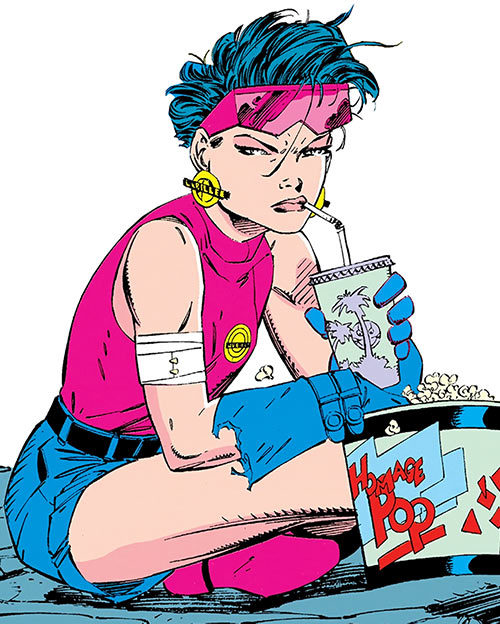

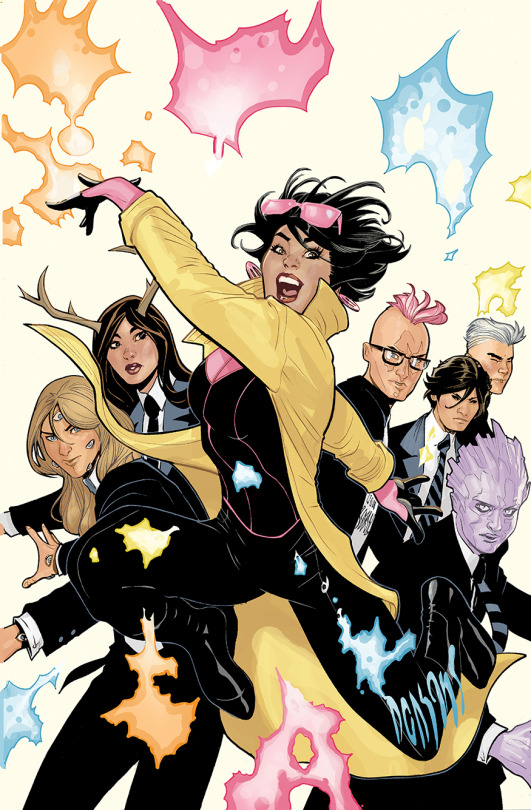






JUBILEE
Jubilation Lee
Update Upon Release
SUCCESS!
Jubilee’s Champion Spotlight has been published for January 2021. Thanks for your support, Summoners!
FINAL MCOC WISHLIST RANK:
#10 most-wanted champ
CHAMPION SPOTLIGHT
https://playcontestofchampions.com/champion-spotlight-jubilee/
EDITOR’S REVIEW
The community asked for a lot of things for this champ, and MCOC came through. Flavor: perfect. Bright pink, yellow, and blue with the proper colored fireworks animations, and a jubilant, youthful attitude. Her mechanics are similar to the way the community envisioned. Things we got right: energy basic attacks, a variety of non-damaging utility debuffs, Prowess. Differences: speculation that she might be a plasma champ, like Havok, was empty: the word “plasmoids” comes up in her Spotlight, but it is apparently only for flavor. Instead her energy plasma damage gives her alternating Shock and Incinerate DOT debuffs. ImagineJim’s idea for persistent charges did not end up in the build, but the persistence of her pre-fight mode selection isn’t totally dissimilar. It is not known whether anyone in the community expected a mode-switching champ. My ideas for light-based debuffs like Dazzle or Fleeting Blindness didn’t happen. My thought she might reduce the effectiveness of her opponent was exactly right, including my suggestion she would reduce Accuracy, which she does by placing Concussion. But she also does it through Suppression (combat power dampening), Slow (disabling Evade and Unstoppable), and perhaps most appropriately Taunt (increasing Special chance). ImagineJim’s idea, that she could consume her Prowess effects came true, but she does it to increase S3 damage, not to Power Gain, as Jim supposed. The “Slippery Mind” trivia piece, that Jubilee is telepath resistant or immune, slipped through the cracks. There’s nothing about Telepathy immunity or resistance in her Spotlight.
ORIGINAL MCOC WISHLIST POLL (RANKER.COM) DESCRIPTION
Probable Class: Mutant (1980s Classic) and/or Mystic (Vampire); #X-Men; Plasma-light blasts look like fireworks. Youthful, exuberant animations. Brightness/blinding/flashbang/dazzle. Telepathy immune.
FULL DESCRIPTION OF PAST SPECULATIONS
High-Level Champ Idea
A playable Jubilee in Marvel Contest of Champions would be Mutant Class. While she has been at times depowered and became a vampire, she’s quintessentially a mutant character.
There are few more colorful, iconic looks among the X-Men than that of Jubilee, with her bright fuchsia accents and electric canary yellow trench coat matching the X-Men logo. She would likely have brightly colorful character design and fireworks attacks, with body language that expresses exuberance and youthful style.
In terms of utility, Summoners would expect a myriad of Energy Damage options, and maybe some kind of sight impairment, Distraction, or Plasma.
In terms of synergies, she should pair up with Wolverine and the 1990s X-Men blue team. Other sparkly-shiny female champs could include Dazzler and Karolina Dean.
Jubilee in Other Games
She’s been in many games, including most recently
Marvel Super War, Marvel Puzzle Quest, and Marvel Future Fight. Update December 2020: she has been teased for Marvel Strike Force, which means she’s now in all the major Marvel mobile games except for MCOC. She was also in the Marvel mobile deck-building games Marvel: War of Heroes and X-Men: Battle of the Atom, and games on other platforms including Marvel Heroes, X-Men Legends and Marvel vs. Capcom: Clash of Super Heroes (1998).
Jubilee and Summoners
She enjoys more than 100 mentions in the Wishlist 3.0 thread on the message boards. She has more than 900 upvotes on the MCOC Wishlist Poll on Ranker, having lived in the top 15-20 on that list for a very long time.
Jubilee is also a fond favorite of the UMCOC Podcast’s celeb host, Dragon, and a favorite of several other well-known content creators. MCOC Futurism Society member TheRealApoc reacted to the announcement in 2020 of The Summoner’s Choice Champion Vote event: “the champion that should be on that poll is for my @McocSociety team member @umcoc_Dragon . . . is Jubilee!” Profile image creator Universal Soldier has also done a piece or two based on the idea of an MCOC Jubilee.
How Summoners Imagine a Jubilee Kit
Summoner HankSpector suggested some synergies here.
The original write up by Other MCOC Gabe, from the MCOC Wishlist Poll, was as follows:
she is an energy-output champ with really fun implications for game animation: fireworks. She can Blind opponents with harmless but bright flashes, or detonate explosions to cause serious Armor Break and Energy Damage. True to the comics, her mind would also be Immune to telepathy.
Content creator ImagineJim, who makes very popular and widely-circulated fan builds of different characters, finally posted his build on June 14, 2020. The editor of this blog, Other MCOC Gabe, collaborated on the build. This is the fan build Jim posted:

In a Theory Thursday feature in June 2020, Other MCOC Gabe tweeted a fan idea for a brightness debuff that Kabam could call “Dazzle,” or something similar, and listed Jubilee among future champs (such as Living Laser, Monica Rambeau, Moonstone, and obviously Dazzler) who could introduce this debuff.
NEWS
Keep an eye out for other blog entries focusing on Jubilee variants, such as her vampire and Tech-class variants.
January 4, 2020: Jubilee’s Champion Spotlight has been published.
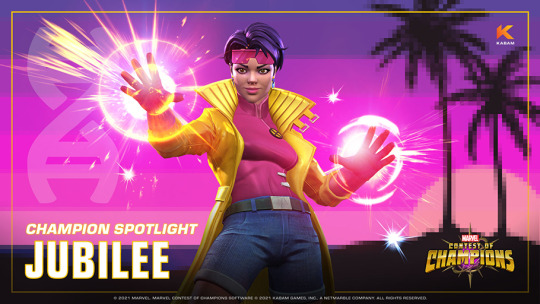
December 28, 2020: the official MCOC Twitter account has teased Jubilee for January 2021, announcing her in the v29.2 release notes!


December 3, 2020, Jubilee was teased by Marvel Strike Force’s Twitter account. Her release in MSF would leave MCOC as the only major Marvel mobile game still not featuring Jubilee.
September 29, 2020, Jubilee has broken back into the top 10 on the MCOC Wishlist Poll on Ranker.
On March 6, 2020, content creator umcoc_Dragon, who helped design the 2020 International Women’s Day Boss Rush event, said that “If Jubilee had been an option? She would have been selected!”
On February 25, 2020, Gabe said that of imaginejim’s three 36-character grids, “about 15 of those are in our plans one way or another for the next couple of years.” He did not clarify how many of those 15 were from the original 36-character #jimgrid. (I hashtagged the mystery champs the #mcocjim15.)
On February 14, 2020, Kabam’s creative director Gabriel Frizzera commented of Twitter-user imaginejim’s grid of 36 requested characters (which I afterward hashtagged the #jimgrid for reference, and which included Jubilee), that “a bunch of those” were planned for champ development.
#jubilee#blind#x men#x men the animated series#dazzle#imaginejim#JimGrid#mcocjim15#Plasma#brightness#light#Asian#Asian female#Chinese#mcoc class mutant#character spotlight
22 notes
·
View notes
Text
Culicicapa

Grey-Headed Canary-Flycatcher by J. J. Harrison, CC BY 3.0
Etymology: Midge Seizer
First Described By: Swinhoe, 1871
Classification: Dinosauromorpha, Dinosauriformes, Dracohors, Dinosauria, Saurischia, Eusaurischia, Theropoda, Neotheropoda, Averostra, Tetanurae, Orionides, Avetheropoda, Coelurosauria, Tyrannoraptora, Maniraptoromorpha, Maniraptoriformes, Maniraptora, Pennaraptora, Paraves, Eumaniraptora, Averaptora, Avialae, Euavialae, Avebrevicauda, Pygostaylia, Ornithothoraces, Euornithes, Ornithuromorpha, Ornithurae, Neornithes, Neognathae, Neoaves, Inopinaves, Telluraves, Australaves, Eufalconimorphae, Psittacopasserae, Passeriformes, Eupasseres, Passeri, Passerida, Paroidea, Stenostiridae
Referred Species: C. ceylonensis (Grey-Headed Canary-Flycatcher), C. helianthea (Citrine Canary-Flycatcher)
Status: Extant, Least Concern
Time and Place: Within the last 10,000 years; in the Holocene epoch of the Quaternary period


Culicicapa is known from the Indian subcontinent, Southeast Asia, Indonesia, and the Philippines; it is also known from southwestern portions of China
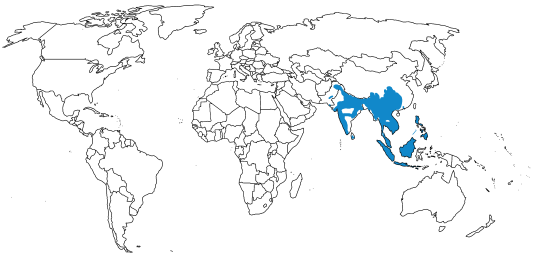
Physical Description: Culicicapa, or the Canary-Flycatchers, is a genus of two types of small, yellow songbirds. These are round birds, with short tails and bright coloration. Ranging between 11 and 13 centimeters in length, they are about the length of a common cell phone, though being birds they are significantly lighter in weight. The birds have small, round heads and short, narrow beaks with fine tips. Both species feature yellow chest and belly feathers, green back feathers, and a mixture of black, green, and yellow feathers on the wings and tail. All sexes are alike in appearance in both species.
Diet: The Canary-Flycatchers primarily eat - you guessed it - flies, and additionally gnats, mosquitos, beetles, wasps, moths, and other small invertebrates. They will use their small beaks to catch insects on the wing. They also will dig in plant material for insects there.
Behavior: These birds are very noisy, making loud, squeaky, and varying calls - these calls can sound like a variety of syllables including tsu-si-tchu-si-si, sweet su sweet, tus-tsu-tswee, pit pit pit, chit-tit-tit-tit-tirr, tit-titu-wheee, and trills. These birds vary by species in terms of group living, as well; the differences between the species are listed below. They breed anytime between March and July; the Grey-Headed Canary-Flycatcher pairs for life, and showcase elaborate courtship rituals. The male will perform short circles of flight in front of the perched female and then will perch next to her, before flying again; he then hovers and displays his butt while the two call to each other. The male then courtship feeds his mate, and after they do the do, the male will build a nest out of moss, lichens, and leaves high up in a tree. They’ll brood in the same nest. The clutches are made of 3 to 4 eggs, and both parents aid in feeding the nestlings. Both species are mainly residential; the Grey-Headed Canary-Flycatcher does show some migration from the HImalayas to the plains of India if a resident of that region; and Chinese populations of the species do migrate back and forth from central to southern China during the year.

Citrine Canary-Flycatcher by Afriefrahman, CC BY-SA 4.0
Ecosystem: These birds live in lowland and mountain forests, mainly in secondary growth and along forest edges; they are mainly found in broadleaf, dry forests and along ravines and gorges as well as along forest edges. The elevation in question that they live in depends mainly on the habitat they’re found in - for example, they tend to be found at higher elevations in locations with higher elevations, etc.
Other: There are some conflicting sources on the behavior of the Grey-Headed Canary-Flycatcher; I have gone here with the most recent source I could find.
Species Differences:
The two species mainly differ on the appearance of the head, as well as their natural ranges. The Grey-Headed Canary-Flycatcher has a grey head (as the name would suggest), including a grey crest of feathers on the top, and lives mainly on the Asian mainland and in Indonesia; the Citrine Canary-Flycatcher lives in the Philippines and has a yellow-green head, with no crest.
They also show extensively different behavior - the Grey-Headed Canary-Flycatchers is more more social, feeding in pairs, groups, and mixed-species foraging flocks. They are also tamer and much more likely to approach people; while the Citrine Canary-Flycatcher is more shy and solitary, though they do form pairs to feed in the breeding season and can join mixed-species foraging flocks.
~ By Meig Dickson
Sources under the cut
Clement, P. 2018. Citrine Canary-flycatcher (Culicicapa helianthea). In: del Hoyo, J., Elliott, A., Sargatal, J., Christie, D.A. & de Juana, E. (eds.). Handbook of the Birds of the World Alive. Lynx Edicions, Barcelona.
Clement, P. 2018. Grey-headed Canary-flycatcher (Culicicapa ceylonensis). In: del Hoyo, J., Elliott, A., Sargatal, J., Christie, D.A. & de Juana, E. (eds.). Handbook of the Birds of the World Alive. Lynx Edicions, Barcelona.
Jobling, J. A. 2010. The Helm Dictionary of Scientific Bird Names. Christopher Helm Publishing, A&C Black Publishers Ltd, London.
Johansson, U. S., J. Fjeldsa, R. C. K. Bowie. 2008. Phylogenetic relationships within Passerida (Aves: Passeriformes): A review and a new molecular phylogeny based on three nuclear intron markers. Molecular Phylogenetics and Evolution 48: 858 - 876.
Vaurie, C. 1953. A generic revision of flycatchers of the tribe Muscicapini. Bulletin of the AMNH 100: 531.
#culicicapa#canary-flycatcher#dinosaur#bird#insectivore#quaternary#India and Madagascar#Eurasia#Australia and Oceania#birblr#factfile#culicicapa ceylonensis#culicicapa helianthea#grey-headed canary-flycatcher#citrine canary-flycatcher#songbird#songbird saturday & sunday#dinosaurs#biology#a dinosaur a day#a-dinosaur-a-day#dinosaur of the day#dinosaur-of-the-day#science#nature
92 notes
·
View notes
Text
Alaska Records Its Warmest Month Ever
New Post has been published on https://newsprofixpro.com/theeyesofthe/2019/08/18/alaska-records-its-warmest-month-ever/
Alaska Records Its Warmest Month Ever
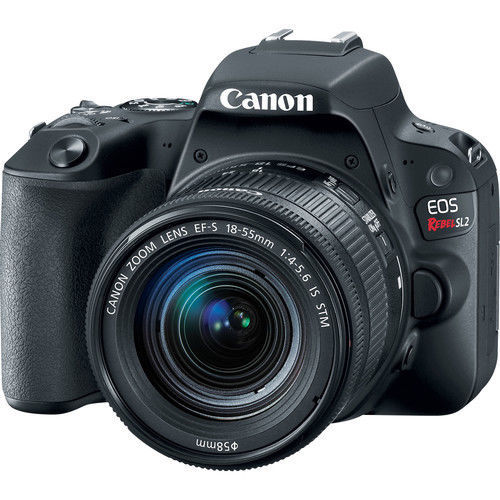
ANCHORAGE, Alaska — Alaska has been America’s canary in the coal mine for climate warming, and the yellow bird is swooning.
July was Alaska’s warmest month ever, according to the National Oceanic and Atmospheric Administration.
Sea ice melted. Bering Sea fi…
Read More

Buy Now



Price: $466.99
Item specifics
Condition:
New: A brand-new, unused, unopened, undamaged item in its original packaging (where packaging is
Brand:
Canon
Series: Canon EOS Rebel Optical Zoom: 3.1x Screen Size: 3.0″ Model:
Canon EOS Rebel SL2
Type: Digital SLR Weight: 14.32 Oz. Connectivity: Remote Control, HDMI Battery Type: Lithium-Ion Megapixels: 24.2MP Features: Body only, Bluetooth, AF Lock, DPOF Support, Audio Recording, Direct Print, Eye-Fi Card Ready, Built-in Flash, Built-in Help Guide, Auto Power Save, Time Lapse, Exposure Compensation, Red-Eye Reduction, Viewfinder, Histogram Display, Noise Reduction, PictBridge Support MPN:
2249C002
Color:
Black
UPC:
013803290806
About this product
Product Identifiers Brand Canon MPN 2249C002 GTIN 0843812108195, 0603784258669, 0738283390975, 0738283390951, 0738283390982, 0748926562379, 0664697861148, 0738283390968, 0664697861162, 0013803290806, 0840102191394 Model Canon EOS Rebel SL2 eBay Product ID (ePID) 240322033 Product Key Features Optical Zoom 3.1x Battery Type Lithium-Ion Features Body only, Bluetooth, AF Lock, DPOF Support, Audio Recording, Direct Print, Eye-Fi Card Ready, Built-in Flash, Built-in Help Guide, Auto Power Save, Time Lapse, Exposure Compensation, Red-Eye Reduction, Viewfinder, Histogram Display, Noise Reduction, PictBridge Support Color Black Series Canon EOS Rebel Screen Size 3.0″ Type Digital SLR Connectivity Remote Control, HDMI Megapixels 24.2MP Dimensions Weight 14.32 Oz. Additional Product Features Exterior Color Black Focal Length Range 18mm-55mm Sensor Resolution 24.2MP Camera Type Digital SLR Sensor Type Cmos Light Sensitivity 100–25600 Lens for Sd EF-S 18-55mm Display Size 3in.




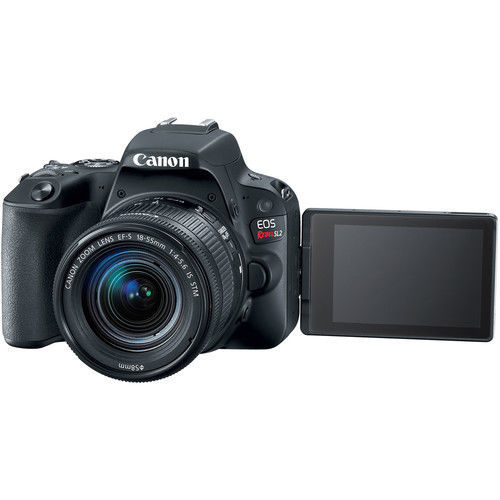



$466.99
End Date: Friday Aug-23-2019 7:31:40 PDT
Buy It Now for only: $466.99
Buy It Now | Add to watch list
0 notes
Text
Shin Godzilla (2016)

Trailer
It’s funny that I approached two seminal deconstructive works - Alan Moore, Dave Gibbons, and John Higgins’s Watchmen and Hideaki Anno’s Neon Genesis Evangelion - before I had experienced the media and the works that they were respectively deconstructing. I read Watchmen in high school, at a time when I was mostly reading Marvel Comics’s output. I didn’t have the frame of reference to understand how Moore, Gibbons, and Higgins were taking apart the idea of the lone vigilante motivated by a traumatic childhood or the godlike superman. I only realized the commentary Watchmen provided after the fact, and reading the commentary alongside the original text became a sport of its own.
Similarly, when I watched Neon Genesis Evangelion for the first time in college, I had not seen the mecha anime that Evangelion was examining. Just as Watchmen took apart the specific tropes and character archetypes of comic books through parallel characters (Dr. Manhattan is Superman, Nite Owl and Rorshach are Batman, the Comedian is Captain America, Silk Spectre is Black Canary), so was Evangelion dissecting the archetypes found in the mecha anime genre. (Shinji Ikari is the ace teenage pilot, like Amuro Ray from Mobile Suit Gundam, Rei Ayanami is the shy, mysterious love interest who is obedient to the protagonist, Asuka Langley Soryu is the rival, hot tempered love interest and ace pilot.)
It’s striking that both deconstructive works found their analytical powers in presenting “real world” consequences of their genre’s respective and specific tropes through mental illness. Only someone suffering from severe mental health issues could attempt to wage a one-man war on crime by putting on a mask and fighting in the streets. A more realistic version of Batman, Moore, Gibbons, and Higgins, posited, would have to look more like Rorshach. Similarly, a scientist who is able to build giant robots that defend mankind would be even more cynical and monstrous than Astro Boy’s Dr. Tenma; he would look more like Gendo Ikari, who is incapable of maintaining any human relationships and treats everyone around him like dirt.

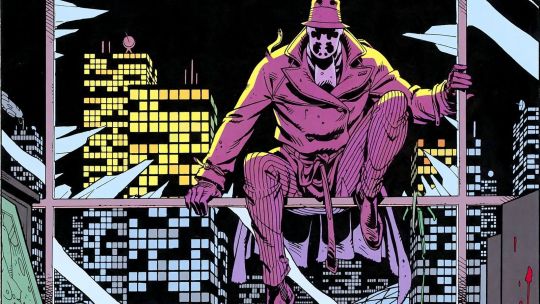


I revisit Evangelion more often than I revisit Watchmen, though Moore and Anno have made it difficult to follow their creative output. Moore’s return to the independent comics publishers to pursue more explicitly sexual, violent, and sexually violent works like Lost Girls, Neonomicon, The Courtyard, and Providence, while Anno’s attempt to retell Evangelion in a new context through the Rebuild of Evangelion movies has stalled with increasingly long delays. Evangelion 1.0: You Are (Not) Alone was released in Japan in 2007, while Evangelion 2.0: You Can (Not) Advance was released in 2009. Evangelion 3.0: You Can (Not) Redo was released in 2012, while production on the final Rebuild of Evangelion film has only barely begun.
Part of the delay in the Rebuild of Evangelion project was Anno’s and Shinji Higuchi’s involvement in Shin Godzilla, which is also known as Godzilla: Resurgence. Anno was contacted to direct Shin Godzilla after falling into depression after completing Evangelion 3.0. Principal photography for Shin Godzilla began in 2015, and the film was released in 2016. It re-positioned Godzilla as a creepy, scary monster, a force of man-made disaster that would serve as allegory for the Japanese triple disaster of the Tohoku earthquake and the subsequent tsunami and the Fukushima Daiichi nuclear disaster of March 2011. (American films will allude to traumatic events in fiction, but more often than not American films will outright try to recreate the traumatic events. You might see Batman vs. Superman: Dawn of Justice, for example, reference the September 11, 2001 terrorist attacks on the World Trade Center, but you’re more likely to see movies that try to recreate that historical event, thereby compressing and distorting history. There’s actually more intellectual honesty in allegorical approach than trying to make a film based on a true story.)


vs.



Furthermore, while Anno and Higuchi criticized the Japanese government’s slow response to the disasters of March 2011 through the way actions to counteract Godzilla’s advance would have to flow from the theatre of action up to sub-commanders to deputy ministers to cabinet ministers to the prime minister, who would make a decision that would have to then travel down the same of communication chain before it was communicated, Anno and Higuchi showed great optimism and faith in Japanese infrastructure. Politicians who could be interpreted as weak or concerned about preserving their reputation could be reinterpreted as figures who are willing to give up power so the country could have a fresh start in the aftermath of Godzilla’s cataclysmic visit, figures who are willing to sacrifice their honor for the country’s sake, or figures who are willing to sacrifice their reputations so they could give citizens the best information they had at the time. There’s a lot of moving from one conference room to another that might seem unnecessary to the impatient viewer, but the conversations in those conference rooms are what lead to solutions.
It helps that Anno and Higuchi find sharp angles to film what could have been devastatingly dull conversations in these conference rooms.



Finding these new angles to show men and women working together to solve the Godzilla problem places the emphasis on their humanity and professionalism. Godzilla will not be defeated by sheer force of Japanese or American arms. While Anno and Higuchi uses gorgeous compositions to show the futile attacks on Godzilla by the Japanese Self-Defense Force, they also show the futility of these attacks in widescreen, captivating shots that also emphasize Godzilla’s magnitude.










Instead, Godzilla can only be defeated when Japanese industrial acumen, business connections, and American arms are combined to form a strategy that requires self-sacrifice and precise timing, hallmarks of Japanese industrial culture. The hope for Japan won’t be found outside the country. Conventional arms cannot defeat Godzilla. Outlandish non-conventional weapons, like MASER cannons or Mechagodzillas, aren’t feasible. Instead, the hope for survival and the future can be found in Japanese systems like its trains and its industries. It’s subtly nationalist in a way that matches resurgent Japanese nationalism under Prime Minister Shinzo Abe’s regime.


Of course, none of this would have been possible if a team of Japanese scientists and officials who do not conform to their institutions had not been grouped together to find a solution. There’s a power to the bureaucracy, the film argues, in coordinating responses among different agencies and in bringing together the outsiders and non-conformists, and there is a role for the “lone-wolves, nerds, troublemakers, outcasts, academic heretics, and general pains in the bureaucracy” in any organization.


The film is similarly conflicted about Japan’s relationship with the United States. American officials are almost always depicted as faceless voices that demand from afar, sending a half-Japanese liaison, Satomi Ishihara’s Kayoko Ann Patterson, to connect with the Japanese crisis team. Ultimately, Patterson sides with the Japanese government at her own risk at a critical moment, prompting the idea that even those who are of Japanese descent living outside Japan are crucial to Japan’s future. Japanese officials are frustrated by American interference in their affairs; the American government goes so far as to propose using a thermonuclear weapon on Godzilla, which horrifies every Japanese official and even Patterson. In the end, the film taps into the renewed sense of Japanese nationalism by showing that Japanese officials can only move forward to solve the Godzilla problem by going their own way, defying the American attempt to take charge, and solving their problem their way.


(There’s probably an essay to be written about how the film treats its three principal female characters: Kayoko Ann Patterson, Mikako Ichikawa’s Deputy Director of Nature Conservation Bureau Hiromi Ogashira, and Kimiko Yo’s Defense Minister Reiko Hanamori. Hiromi and Patterson are probably around the same age, and they’re equally outsiders. Patterson is the American half-Japanese liaison, while Hiromi is outspoken and somewhat socially awkward. Patterson is much more conscious about her physical appearance, while Hiromi wears no make-up at all. Reiko stands apart from them both; older than both other women, Reiko is a senior official in the Japanese cabinet and the military’s voice for the Prime Minister.)
Anno, Higuchi, and composer Shiro Sagisu also layer in plenty of homages for Evangelion fans. Based on my impressions, I’ve found these callbacks:
The use of the track “Decisive Battle” from the Evangelion soundtrack to spice up scenes of men and women working in conference rooms
The way the film places a visual emphasis on Japanese trains
The way Anno and Higuchi framed their shots of tanks, aircraft, and artillery pieces bombarded Godzilla in the same ways that they attacked Angels throughout Evangelion
The way they focused on Godzilla’s eyes to show its monstrosity in the same way they focused on Eva-01′s eyes to show its near-humanity
The way the final shot echoed the Failures of Infinity in the Evangelion: 3.0+1.0 teaser trailer at the end of Evangelion 3.33
The way the lights turned out in the underground shelter echoed the way the lights went out during an Angel attack
The way Godzilla attacked all around him echoed the way Ramiel defended itself in Evangelion 2.0
The way Godzilla’s blood plopped to the ground echoed the way various Angels’ blood would fall after they were killed
The way military officials were framed when they released their attacks on Godzilla/the Angels were ineffective
The Japanese Twitter user named “bakashinji” who had an Asuka avatar.


While the film is dialogue heavy, it never feels slow. And it’s a surprisingly funny film, from Godzilla’s googly eyes in its first appearances to the way that an official’s title becomes a visual gag in subtitles because it takes up almost half the screen.

It was everything that I had hoped for from a film by Anno and Higuchi: satirical, strangely hopeful, dynamically shot, wonderfully scored. In other words,

#shin godzilla#hideaki anno#shinji higuchi#shiro sagisu#godzilla#kaiju#hiroki hasegawa#yutaka takenouchi#ishihara satomi
183 notes
·
View notes
Photo



dinah lance - 8.02 “welcome to hong kong”
#dcedit#arrowedit#dcladies#dcmultiverse#dinahlaurellancesource#theworldneedslaurellance#dcugifs#dailytvwomen#cinematv#laurellanceedit#dctvedit#laurel lance#dinah lance#black canary 3.0#dc#dctv#8x02#season 8#gifs#my gifs
93 notes
·
View notes
Photo


#pretty birds
#dcedit#dcladies#dcmultiverse#dinahlaurellancesource#theworldneedslaurellance#dctvedit#arrowedit#dinahdrakeedit#laurellanceedit#blackcanaryedit#dinah drake#black canary 2.0#e2 laurel lance#black canary 3.0#dc#dctv#tv: arrow#gifs#**#***#dl*
138 notes
·
View notes
Text
Kwame Bonsu among five African based players that are ready for the European market
Their prized assets have become easy targets for European clubs to pounce on, and with no end to the crisis in sight, a player exodus looms.
Here are five players playing in Africa who are ready for a move to Europe.
Jackson Muleka
Age: 20
Club: TP Mazembe
When Jackson Muleka stepped up to take the penalty against Raja in the second leg of the CAF Champions League quarterfinals, one he would subsequently miss, it was a tragic end to a fantastic campaign. His 7 goals had propelled his team to the latter rounds of the competition, composing 58% of TP Mazembe’s goals in the tournament.
A young, lethal fox in the box, Muleka’s services are in high demand, with both Al-Ahly and newly promoted RC Lens eyeing him to beef up their attack. The Congolese striker’s small frame hides an explosiveness and upper body strength that can destabilize defenders 10 years his senior, and at just 20 years old, it’s only a matter of time before he gets a move abroad.
An academy product of TP Mazembe, he reminds the Lumumbashi faithful of Mbwana Samatta, who terrorized defences before leaving for Genk in 2016. Muleka has smashed Samatta’s goal record in two fewer seasons, hitting 60 goals in the last 24 months.
Austin Oladapo
Age: 24
Club: Enyimba International FC
Since joining from Gombe United on a free transfer in 2017, Austin Oladapo has emerged as a key performer on the right side of Enyimba’s midfield trio. He is adept at drifting in between the lines, winning fouls, and advancing possession, and his 3.9 accurate long passes per game rank him amongst fourth amongst midfielders in Nigeria’s first division.
Oladapo is the only other midfielder who has made the Nigerian Professional Football League Team of the Week on multiple occasions this season, the other being his teammate Stanley Dimgba. He is a restless worker who has a penchant for scoring a belter, as evidenced from his three goals this season.
Amongst Oladapo’s 5 goals in the league this season, all have come from outside the box. He is the most versatile midfielder in manager Fatai Osho’s machine; while he complements Cyril Olisema’s vision and Farouk Mohammed’s tackling, he also combines the former’s passing range and the latter’s tenacity.
Badredinne Souyad
Age: 25
Club: JS Kabylie
Despite being eliminated in the CAF Champions League group stage, JSK Kabylie’s Badredinne Souyad made a name for himself as a padlock in the heart of defense, impressing both at center back and defensive midfielder. The Algerian averaged the most interceptions per game in the group stage with 3.0, whilst ranking seventh in clearances per game with 5.0. When things get ugly, he’s up to the task to put out the danger, but he doesn’t overdo it — he has never picked up a sending-off during his time in Tizi Ouzou.
He has featured in all but four games for the Canaries, an ever-present in defense. He isn’t all brawn though; he can spread the ball with pinpoint long balls and manifests his impeccable timing to make game-changing interceptions and tackles. As the reigning AFCON champions look to strengthen their side ahead of World Cup qualifications, Souyad could win a starting spot in the Desert Foxes’s defense next to Aïssa Mandi.
Kwame Bonsu
Age: 25
Club: Espérance Sportive de Tunis
Following in the footsteps of his compatriots Michael Essien and Thomas Partey, Kwame Bonsu has built a reputation for himself as Ghana’s next top midfield star. He left his homeland at 18 years old for Sweden, where he would bounce from FC Rosengård to Mjällby AIF to Gefle IF, before returning home in 2018.
He departed Ghana last year for Tunisian side Espérance Sportive de Tunis, where he has since made a name for himself as one of the top midfielders in West Africa.
Bonsu is a press-resistant player who can shrug off opponents with his trademark upper body feints and turns, and his assured approach in winning physical duels makes him a player who can play a supporting role for the Black Stars in the coming years. While he needs to improve his passing to get his second international call-up, Bonsu is a promising player who is banging the drum for another move to Europe.
5. Abdelraouf Benguit
Age: 24
Club: Espérance Sportive de Tunis
A versatile performer who has turned into a key player for Espérance, Abdelraouf Benguit can play as a defensive midfielder, central midfielder and right back. In the CAF Super Cup loss to Zamalek, he ruled the roost from midfield, while also drifting to right back to keep things ticking in possession. He is Algeria’s answer to Joshua Kimmich, a superb passer who can do a job in midfield or on the right side of defense.
He is rarely dribbled past and is adept at winning fouls, suffering 1.7 fouls per fixture, and according to SofaScore, Benguit was statistically the third best player in the CAF Champions League in 2019/20.
By: Tosin Holmes for breakingthelines.com
source: https://footballghana.com/
0 notes
Text
Kwame Bonsu among five African based players that are ready for the European market
Their prized assets have become easy targets for European clubs to pounce on, and with no end to the crisis in sight, a player exodus looms. Here are five players playing in Africa who are ready for a move to Europe.
Jackson Muleka
Age: 20
Club: TP Mazembe
When Jackson Muleka stepped up to take the penalty against Raja in the second leg of the CAF Champions League quarterfinals, one he would subsequently miss, it was a tragic end to a fantastic campaign. His 7 goals had propelled his team to the latter rounds of the competition, composing 58% of TP Mazembe’s goals in the tournament.
A young, lethal fox in the box, Muleka’s services are in high demand, with both Al-Ahly and newly promoted RC Lens eyeing him to beef up their attack. The Congolese striker’s small frame hides an explosiveness and upper body strength that can destabilize defenders 10 years his senior, and at just 20 years old, it’s only a matter of time before he gets a move abroad.
An academy product of TP Mazembe, he reminds the Lumumbashi faithful of Mbwana Samatta, who terrorized defences before leaving for Genk in 2016. Muleka has smashed Samatta’s goal record in two fewer seasons, hitting 60 goals in the last 24 months.
Austin Oladapo
Age: 24
Club: Enyimba International FC
Since joining from Gombe United on a free transfer in 2017, Austin Oladapo has emerged as a key performer on the right side of Enyimba’s midfield trio. He is adept at drifting in between the lines, winning fouls, and advancing possession, and his 3.9 accurate long passes per game rank him amongst fourth amongst midfielders in Nigeria’s first division.
Oladapo is the only other midfielder who has made the Nigerian Professional Football League Team of the Week on multiple occasions this season, the other being his teammate Stanley Dimgba. He is a restless worker who has a penchant for scoring a belter, as evidenced from his three goals this season.
Amongst Oladapo’s 5 goals in the league this season, all have come from outside the box. He is the most versatile midfielder in manager Fatai Osho’s machine; while he complements Cyril Olisema’s vision and Farouk Mohammed’s tackling, he also combines the former’s passing range and the latter’s tenacity.
Badredinne Souyad
Age: 25
Club: JS Kabylie
Despite being eliminated in the CAF Champions League group stage, JSK Kabylie’s Badredinne Souyad made a name for himself as a padlock in the heart of defense, impressing both at center back and defensive midfielder. The Algerian averaged the most interceptions per game in the group stage with 3.0, whilst ranking seventh in clearances per game with 5.0. When things get ugly, he’s up to the task to put out the danger, but he doesn’t overdo it — he has never picked up a sending-off during his time in Tizi Ouzou.
He has featured in all but four games for the Canaries, an ever-present in defense. He isn’t all brawn though; he can spread the ball with pinpoint long balls and manifests his impeccable timing to make game-changing interceptions and tackles. As the reigning AFCON champions look to strengthen their side ahead of World Cup qualifications, Souyad could win a starting spot in the Desert Foxes’s defense next to Aïssa Mandi.
Kwame Bonsu
Age: 25
Club: Espérance Sportive de Tunis
Following in the footsteps of his compatriots Michael Essien and Thomas Partey, Kwame Bonsu has built a reputation for himself as Ghana’s next top midfield star. He left his homeland at 18 years old for Sweden, where he would bounce from FC Rosengård to Mjällby AIF to Gefle IF, before returning home in 2018.
He departed Ghana last year for Tunisian side Espérance Sportive de Tunis, where he has since made a name for himself as one of the top midfielders in West Africa.
Bonsu is a press-resistant player who can shrug off opponents with his trademark upper body feints and turns, and his assured approach in winning physical duels makes him a player who can play a supporting role for the Black Stars in the coming years. While he needs to improve his passing to get his second international call-up, Bonsu is a promising player who is banging the drum for another move to Europe.
5. Abdelraouf Benguit
Age: 24
Club: Espérance Sportive de Tunis
A versatile performer who has turned into a key player for Espérance, Abdelraouf Benguit can play as a defensive midfielder, central midfielder and right back. In the CAF Super Cup loss to Zamalek, he ruled the roost from midfield, while also drifting to right back to keep things ticking in possession. He is Algeria’s answer to Joshua Kimmich, a superb passer who can do a job in midfield or on the right side of defense.
He is rarely dribbled past and is adept at winning fouls, suffering 1.7 fouls per fixture, and according to SofaScore, Benguit was statistically the third best player in the CAF Champions League in 2019/20.
By: Tosin Holmes for breakingthelines.com
source: https://ghanasoccernet.com/
0 notes
Text
Samsung presenta Galaxy Fold, la gamma S10 e i nuovi indossabili per il fitness
Si è spesso dibattuto su come e quanto Samsung possa ispirarsi ad Apple, dividendo la platea tra sostenitori e detrattori del colosso coreano. Un ambito in cui Samsung sta migliorando quest'eventuale ispirazione è probabilmente quello commerciale: proprio come Apple, ha imparato a dissociarsi dagli eventi tecnologici tradizionali per "terrorizzare" a puntino le rivali che invece preferiscono porti sicuri come il Mobile World Congress. Che per l'appunto è tra pochi giorni, e questo è un elemento di differenziazione con la strategia di Apple: nel bene e nel male, a mesi di distanza sai che l'iPhone può ancora costituire una presenza ingombrante all'ombra ma hai una possibilità di replica appropriata. Nel caso dei Galaxy, sarà molto dura per le altre mostrare questo weekend delle controffensive in grado di smorzarne l'inevitabile predominio della scena (prudentemente Huawei ha deciso di agire a fine marzo ad acque più chete).
Basta digressioni, però, e veniamo a ciò che ha presentato Samsung qualche ora fa. Non iniziamo tuttavia dagli S10, bensì da un altro dispositivo molto atteso e soprattutto pieghevole. Il Galaxy Fold, appunto. Guardandolo da chiuso può non sembrare esteticamente così invitante. Lo schermo stesso da 4,6", per quanto Super AMOLED con risoluzione 840x1960, è piccolo in confronto agli standard odierni. Ma nelle intenzioni di Samsung, la maggior parte delle volte questo prodotto lo si utilizzerà aperto, rivelando 7,3" tutti a disposizione dell'utente.
Non c'è trucco, non c'è inganno: nessuna linea di demarcazione a metà dello schermo, con risoluzione 1536x2152. Samsung lo chiama Infinity Fold, e ricopre quasi per intero la superficie del dispositivo aperto fatta eccezione per la parte destra superiore dove sono racchiuse le fotocamere anteriori. Buona parte del merito va al nuovo strato di polimeri aggiunto, che in aggiunta ad un pannello leggero specifico per il Galaxy Fold ha conferito al display ottime doti di flessibilità senza sacrificare la resistenza. Non sono però meno fondamentali i cardini strutturati per garantire centinaia di migliaia di aperture a libro senza conseguenze.
Guardando ora alle caratteristiche tecniche sotto la scocca, troviamo un SoC octa-core da 7 nm (non viene però meglio specificato di quale si tratti, se un proprietario Exynos o uno Snapdragon), assieme a 12 GB di RAM LPDDR4X e 512 di spazio d'archiviazione UFS 3.0. Per quel che riguarda le fotocamere, il Galaxy Fold ne include 6 complessive. Si parte dal trio nella parte posteriore, composto da un sensore ultra-grandangolare da 16 Megapixel con apertura f/2,2, un "semplice" grandangolare da 12 Megapixel f/2,4 comprensivo anche di autofocus dual pixel e stabilizzazione ottica e un teleobiettivo da 12 Megapixel in grado di realizzare uno zoom ottico 2x. La coppia presente nel dispositivo aperto prevede invece un sensore principale da 10 Megapixel f/2,2 e uno secondario da 8 Megapixel dedicato soprattutto al rilevamento della profondità. L'ultima fotocamera si trova infine nel frontale del dispositivo chiuso ed è da 10 MP.
Il comparto audio è curato altrettanto quanto quello video, con la presenza di altoparlanti stereo firmati AKG. La dotazione di connettività comprende 4G, Wi-Fi 802.11ac, NFC e Bluetooth 5.0, mentre il riconoscimento biometrico è affidato ad un sensore d'impronte a lato. Il sistema a doppia batteria è in grado di erogare complessivamente 4.380 mAh, con possibilità di ricarica rapida e wireless così come di caricare a sua volta senza fili un altro dispositivo.
Image from The Verge.
Parlando del software, il Galaxy Fold include alla base Android 9.0 Pie con le personalizzazioni proprietarie One UI; considerata però la particolare natura del prodotto, Samsung ha lavorato a stretto contatto sia con Google sia con gli sviluppatori di app per offrire da subito un'esperienza ottimizzata. Nella modalità Multi-Active è possibile avere a schermo ed utilizzare tre app aperte contemporaneamente, mentre una continuità interna permette d'iniziare le operazioni sul più piccolo display a dispositivo chiuso e proseguirle una volta aperto al punto esatto in cui ci si era interrotti (il discorso vale anche viceversa, da aperto a chiuso). Non manca nemmeno il supporto DeX, che permette collegando il dispositivo ad un'apposita docking station, a sua volta collegato a monitor, tastiera e mouse, di sfruttarlo quasi come se fosse un computer tradizionale all'interno di un ambiente desktop. Galaxy Fold arriverà nelle tonalità Space Silver, Cosmos Black, Martian Green ed Astro Blue, acquistabile dal 26 aprile ad un prezzo non per deboli di cuore, $1980 (quello europeo dovrebbe rimanere abbastanza fedele, attorno ai 2.000 €).
Parliamo ora dei Galaxy S10. Sono tre, anzi di più. Iniziamo però dal trio principale, dato che il quarto è un po' più particolare. Come previsto dai vari leak, per la decima iterazione del suo celebre smartphone top Samsung ha stravolto l'estetica, riducendo drasticamente i bordi anche sopra e sotto e ricollocando la fotocamera anteriore all'interno dello schermo, quello che alcuni hanno scherzosamente ribattezzato "buco". Parlando proprio dei display, non si parla più di Super AMOLED ma di Dynamic AMOLED. La parte dinamica è applicata nello specifico alla mappatura dei toni, che insieme ad altri miglioramenti e al supporto HDR10+ garantiscono secondo Samsung una resa decisamente migliore rispetto ai già buoni pannelli di S9. È integrato anche un filtro luce blu, riducendo così la necessità di ricorrere ad effetti software, e soprattutto un sensore d'impronte ultrasonico, che agisce attraverso una scansione tridimensionale della superficie del dito.
Dentro, come da tradizione troviamo il meglio dei flagship di casa Samsung, con SoC octa-core, RAM LPDDR4X in abbondanza e spazio d'archiviazione base ulteriormente espandibile tramite microSD. Feature immancabile dei recenti prodotti di punta è la NPU dedicata a tutte le funzionalità d'intelligenza artificiale. Essa viene adottata per ottimizzare nell'uso le prestazioni del dispositivo, mantenere la connessione più stabile e, come vedremo tra poco, predisporre sin da subito scatti fotografici nelle migliori condizioni. A ciò si aggiunge l'assistente digitale Bixby, controrisposta Samsung degli ultimi anni ad Alexa e Siri e che proprio da oggi parla anche italiano.
A livello fotografico, ognuno dei tre dispositivi fa un po' storia a sé, ma ci ritorneremo a breve. Nel frattempo iniziamo dalle caratteristiche peculiari per tutti, a partire dal sensore ultra-grandangolare con campo di visione fino a 123°, un nuovo sistema di stabilizzazione digitale per i video (in affiancamento a quello ottico) e il supporto HDR10+ in registrazione. Sono presenti le tecnologie già note dai precedenti modelli come Dual Pixel e l'apertura doppia, f/1,5-f/2,4 sul sensore principale. Come già anticipato nel paragrafo sopra, l'intelligenza artificiale è un perno del sistema fotografico degli S10, con la possibilità di riconoscere fino a 30 tipi di scene e soggetti per ottimizzazioni sia automatiche sia manuali; nel secondo caso, ad esempio, durante uno scatto al tramonto all'utente potrà essere proposto di affidare il compito all'ultra-grandangolare. Per i ritratti sono stati aggiunti ulteriori effetti bokeh a quelli già esistenti, mentre guardando alla fotocamera anteriore è supportata la realizzazione di AR Emoji sulla base del proprio volto.
Anche stavolta nel comparto audio stereo troviamo lo zampino di AKG, cui si aggiunge pure il supporto Dolby Atmos. La connettività prevede LTE fino a 2 Gbps, Wi-Fi 6, NFC e Bluetooth 5.0. Il comparto energetico supporta sia la ricarica rapida che quella wireless e, come già nel caso del Galaxy Fold, dà a sua volta con la modalità PowerShare l'opportunità di ricaricare altri prodotti compatibili con gli standard senza fili. La resistenza costruttiva è affidata alla certificazione IP68 contro liquidi e polveri. Il sistema operativo preinstallato è Android 9.0 con One UI e non mancheranno app espressamente ottimizzate per questi nuovi prodotti, come Adobe Premiere Rush CC. Finora abbiamo elencato le caratteristiche comuni a tutti gli S10, ora guardiamo singolarmente a ciò che portano in dote.
S'inizia dal più piccolo della gamma: Galaxy S10e. Ad esso il compito di scontrarsi direttamente con un certo XR, tanto sul piano tecnico quanto su quello economico. Ha uno schermo da 5,8" Full HD+ non curvo con sensore d'impronte capacitivo invece che ultrasonico, 6 GB di memoria RAM e 128 di storage. Le fotocamere posteriori sono due, la principale da 12 Megapixel e l'ultra-grandangolare da 16. Non è previsto il sensore teleobiettivo, anche se un minimo di zoom ottico, pari a 0,5x, viene comunque dichiarato pure qui. Davanti è presente una fotocamera da 10 Megapixel. La batteria integrata è da 3.100 mAh. Sarà disponibile al prezzo di 779 € a partire dall'8 marzo prossimo, nelle tonalità Prism White, Prism Black, Prism Green, Prism Blue, Flamingo Pink e Canary Yellow, quest'ultima esclusiva proprio del modello S10e. È preordinabile insieme agli altri da Amazon, coi link inseriti in corrispondenza dei prezzi.
S10 si colloca nel mezzo, portando lo schermo a quota 6,1" con risoluzione Quad HD+. Riguadagna anche le curvature ai lati, così come il sensore d'impronte ultrasonico. Ci sono due GB di RAM in più, per un totale di 8, mentre per l'archiviazione è disponibile anche una variante da 512 GB. Alle due fotocamere posteriori soprammenzionate per S10e si aggiunge qui il terzo sensore teleobiettivo da 12 Megapixel, che permette uno zoom ottico sino a 2x. La batteria è da 3.400 mAh. Sarà disponibile nelle medesime tonalità di S10e, fatta eccezione per il Canary Yellow, e costerà 929 € nella versione 8/128 GB e 1.179 € in quella 8/512 GB.
Chiude il cerchio Galaxy S10+, che alza ancora un po' le dimensioni dello schermo, qui da 6,4". Sempre sulla base di questo principio a step, aggiunge un ulteriore taglio d'archiviazione da ben 1 TB nonché una seconda fotocamera anteriore da 8 Megapixel per il rilevamento della profondità. La batteria è da 4.100 mAh. Si potrà acquistare nelle stesse tonalità di S10 più altre due scelte: Ceramic Black e Ceramic White. Il prezzo è di 1.029 € per 8/128 GB, 1.279 € per 8/512 GB e 1.639 € per 8 GB/1 TB (quest'ultimo al momento appare l'unico non disponibile al preordine).
Ma abbiamo detto più sopra che c'è pure un quarto modello, che arriverà più avanti degli altri. È il Galaxy S10 5G, un mostro da 6,7" che, come suggerisce il nome stesso, ha il suo cavallo di battaglia proprio nel supporto alle reti di nuova generazione. In realtà non si distingue solo per queste due differenze: ha anche due fotocamere 3D per il riconoscimento della profondità, una davanti ed una dietro, così come una batteria da 4.500 mAh che prevede una modalità di ricarica ancor più rapida. Ne sentiremo riparlare più avanti nel corso dell'anno. Anche in Italia? Affermativo: Samsung ha già stretto accordi con TIM e Vodafone per la commercializzazione del Galaxy S10 5G, che darà così manforte al prossimo lancio delle nuove reti dei due operatori.
Andiamo verso la chiusura di questo lunghissimo post parlando degli indossabili che Samsung ha introdotto oggi. Le Galaxy Buds sono le nuove proposte coreane per gli auricolari senza fili, con suono a cura di AKG, sistema di enfatizzazione dei rumori ambientali che consente di non isolarsi completamente dal mondo circostante senza compromettere la qualità di riproduzione e doppio microfono. L'autonomia garantita è di 6 ore in ascolto musicale o 15 in chiamata; per ricaricarle, è sufficiente porle nel loro case che può agire da "banca energetica" per un totale di 7 ore aggiuntive. Se si è di fretta, è possibile accontentarsi della ricarica rapida che restituisce in 15 minuti agli auricolari poco meno di due ore d'autonomia o ancora condividere in modalità wireless un po' di batteria dal proprio Galaxy S10. Non manca l'integrazione con l'assistente Bixby pr effettuare una serie d'operazioni senza dover azionare direttamente lo smartphone. Saranno disponibili in nero, bianco e giallo al prezzo di 149 € a partire dall'8 marzo. Per chi preordina uno degli S10 in questa fase sono incluse nel prezzo.
Il Galaxy Watch Active si aggiunge alla già nutrita schiera di smartwatch Samsung, con un design che strizza più l'occhio agli sportivi pur mantenendo gran parte delle caratteristiche del modello più raffinato introdotto lo scorso anno. Ha anche una sua peculiarità, ovvero il monitoraggio della pressione sanguigna (solo in nazioni selezionate ed Italia esclusa), compito per la prima volta affidato ad uno smartwatch non proveniente da aziende mediche specializzate. Arriverà dal 15 marzo al prezzo di 249 €, nelle tonalità Silver, Black, Rose Gold e Sea Green. Poco dopo ed a prezzi decisamente inferiori arriveranno i due modelli Galaxy Fit, il secondo contrassegnato dalla e finale, che si distingue dal fratello maggiore soprattutto per schermo (bianco e nero contro colori), NFC (non presente nel Fit e) e batteria (70 contro 120 mAh). Entrambi condividono però impermeabilità fino a 5 ATM e sensore di battito cardiaco.
L'articolo Samsung presenta Galaxy Fold, la gamma S10 e i nuovi indossabili per il fitness proviene da SaggiaMente.
Articoli correlati:
Il Galaxy S10 arriverà il 20 febbraio al prossimo Samsung Unpacked, e potrebbe non essere da solo Samsung è quasi pronta a spacchettare il suo prossimo Galaxy...
ecco il Galaxy S10+ svelato dalla stessa Samsung Domani Samsung terrà il classico evento unpacked in cui svelerà...
Samsung starebbe pensando a un proprio HomePod La presentazione di HomePod ha sancito (con un nome piuttosto...
from Samsung presenta Galaxy Fold, la gamma S10 e i nuovi indossabili per il fitness
0 notes
Text
Zenaida

White-winged dove by Snowmanradio, CC BY 2.0
PLEASE SUPPORT US ON PATREON. EACH and EVERY DONATION helps to keep this blog running! Any amount, even ONE DOLLAR is APPRECIATED! IF YOU ENJOY THIS CONTENT, please CONSIDER DONATING!
Genus Name: Zenaida
Status: Extant
First Described: 1838
Described By: Bonaparte
Classification: Dinosauria, Theropoda, Neotheropoda, Averostra, Tetanurae, Orionides, Avetheropoda, Coelurosauria, Tyrannoraptora, Maniraptoriformes, Maniraptora, Pennaraptora, Paraves, Eumaniraptora, Averaptora, Avialae, Euavialae, Avebrevicauda, Pygostylia, Ornithothoraces, Euornithes, Ornithuromorpha, Ornithurae, Neornithes, Neognathae, Neoaves, Columbaves, Columbimorphae, Columbiformes, Columbidae, Columbinae, Zenaidini
Referred Species: Z. asiatica (White-winged dove), Z. meloda (West Peruvian dove), Z. aurita (Zenaida dove), Z. galapagoensis (Galápagos dove), Z. auriculata (Eared dove), Z. macroura (Mourning dove), Z. graysoni (Socorro dove)
Happy Birthday Week! This year’s theme is my favorite genera of Modern dinosaurs (aka, birds)! The first one is the Zenaida doves, a small genus of doves native to America that includes my favorite Columbid, the Mourning Dove! This genus has seven species that are all fairly similar - small, tan with black spots. The reason I love the Mourning Dove so much is its distinctive call - it truly is beautiful, and one lived outside my window as a kid and would greet me when I woke up!

West Peruvian Dove, by DickDaniels, CC BY-SA 3.0
Zenaida is, for the most part, a genus that is non-endangered, apart from one species that is extinct in the wild. They are also closely related to the Passenger Pigeon, which is now extinct. Though they all live in the Americas, the range of each differs, with some overlap between certain species. They probably diverged from other doves sometime between 2 and 3 million years ago, originating mainly in North America and then spreading to South America following the formation of the land bridge between the two continents. Fossils of this genus are known from recent rocks from Florida, California, Arizona, New Mexico, Colorado, the Carribbean, and Ecuador.

Mourning Dove by Trisha M. Shears, in the Public Domain
The white-winged dove, Z. asiatica, lives in the southwestern region of the United States, down through Mexico and the Caribbean, and has expanded through Texas, Oklahoma, Louisiana, and Mississippi. It also, sadly, has been introduced to Florida. They are round doves, about 29 centimeters long, with brownish grey upper plumage and gray lower plumage. They also have patches of blue, featherless skin around each eye as adults. They have a cooing call, like other doves and pigeons, that goes hoo, hoo, hoo-hoo. They also call out hoo-a to warn for predators.
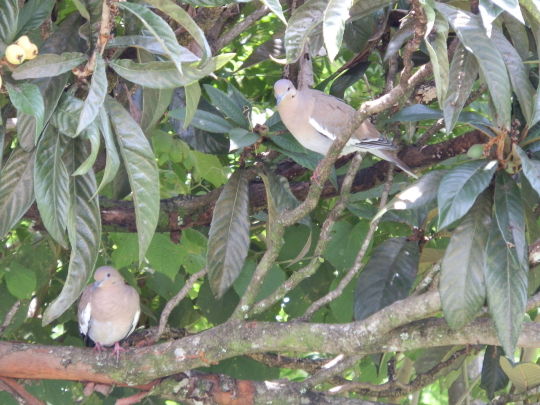
White-Winged Doves by Gabriel Gianello, CC BY-SA 3.0
The West Peruvian Dove, Z. meloda, lives primarily from Ecuador the Chile, mostly in subtropical and tropical environments, both dry and wet. They have a bright blue patch of skin around each eye, and have brown eyes, with both sexes fairly similar in coloration. They are probably not threatened, and they have a caw of hoo-hoo-WOO... hoo-hoo-WOO-hoo. The Zenaida Dove, Z. aurita, is also not endangered - they live in the Caribbean and Yucatán Peninsula, with some even reaching the Florida Keys. They are about 28 to 30 centimeters long, and are similar in appearance to Mourning Doves, but are smaller with shorter and rounder tails, and darker coloration. It will roost in trees, shrubs, and rock crevices and grassy vegetation. They also forage on the ground, and have similar calls to Mourning Doves, but have a faster pace.
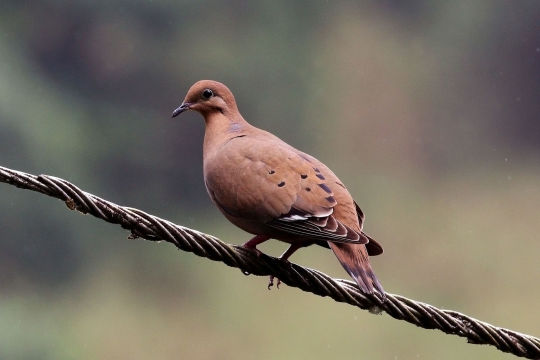
Zenaida Dove, by Charlesjsharp, CC BY-SA 4.0
The Galápagos Dove, Z. galapagoensis, is endemic to the Galápagos Island and is very common there. They are between 18 and 23 centimeters long and has streaked white and black wings. They are actually very reluctant to fly, and mostly eat seeds and fruit from the ground, living in rocky lowlands. They also pollinate cacti, due to an absence of bees. They build their nests on the ground, carrying two eggs in each nest.

Galápagos Dove, by The Rambling Man, CC BY-SA 3.0
The Eared Dove, Z. auriculata, is a dove from Colombia, Argentina, and Chile. It is partially migratory as well, moving due to food supply changes. It is 24 cm long, with blue-black coloration on its ear feathers, giving the bird it’s name. They have a soft call, oo-ah-oo, and they’re common in savannah and other sorts of open habitats. It has fast and high flight, with mating flights that have steep aerial climbs. They nest in trees, laying two eggs in each nest.

Eared Dove, by Alex Proimos, CC BY 2.0
The Socorro Dove, Z. graysoni, is a species that is extinct in the wild, but still present in captivity, with reintroduction programs being prepared at various zoos. It is closely related to mourning doves and can hybridize with other members of the species. It is about 26.5 to 34 cm long, with stronger but similar colors to the mourning dove. It has a disyllabic coo, followed by three single calls, and then another disyllabic calls, all taking less than 3 second to go together. It lives only in mated pairs or solitarily, unlike other doves of this genus, and the young are chased away from the nest immediately upon being able to care for themselves. They lived in low seasonably humid forests, and upon the introduction of cats, these habitats became more dangerous for them, as they lived in the lowland, eating fruit from the local fruit trees that also have become less common. Feral cats, human hunting, and competition with other animals reduced their population until they went extinct in the wild. Reintroduction efforts have begun, reducing sheep populations, controlling cats, and breeding programs are in place.
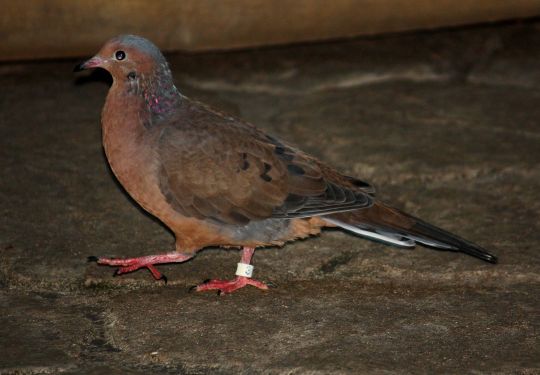
The Socorro Dove, by Ltshears, CC BY-SA 3.0
The Mourning Dove, Z. macroura, is arguably the most famous species, and the reason why this is one of my favorite genera of birds. It is abundant, widespread, and not endangered, with year-round range in most of the US and Mexico, with winter only ranges in the southern portion of Central America, and the summer only range in southern Canada. It is most closely related to the eared dove and the Socorro dove, but these are thought to be separate species from one another. It has five subspecies, which have overlapping ranges, and all appear fairly similar to one another. It is a slender dove, about 31 cm long, with broad wings and a round head, with a long and tapered tale. They’re usually light, gray-brown and pinkish below, with black spotting on the wings. The males also have purple-pink patches on the sides of the neck.

Mourning Dove, CC BY-SA 2.5
They live in a wide variety of habitats including urban areas, farms, prairies, grasslands, and woods. It lives well alongside humans and migrate over land, during the day and at low altitudes, but not all Mourning Doves mate. There are even some Canadian doves that stay in the winter, feeding off of Bird Feeders. They have a very distinctive call, a sort of Coo-OOO-cooo, coo, coo, which you can hear here: https://commons.wikimedia.org/w/index.php?title=File%3AMourning_Dove.ogg. This call is why they’re so fond to me. They also can have a nest call that’s shorter to attract mates, a soft ork for greeting when re-meeting mates, and a short alarm call.

Mourning Dove pair, by Andrew Atzert, CC BY 2.0
The male initiates courtship with a noisy flight, then a circular glide to land, before approaching the female with a puffed out breast and a bobbing head. The pair will preen each other’s feathers, and then they’ll find potential nest sites, with the female dove building the nest. They construct nests out of twigs, conifer needles, and glass blades, so they’re never very strong nests. They’re usually made in trees, and they usually lay only two eggs. The young hatch after two weeks and are altricial, meaning that they are helpless and require the aid of their parents. They fledge - so become more mature, but not quite able to fly - in about 11 to 15 days, and stay nearby the nest for two weeks after to be fed by the father. The dove is monogamous, forming strong pair bonds, which reconvene in the same area after the breeding season.

By Snowmanradio, CC BY-SA 2.0
They feed almost exclusively seeds, though occasionally they eat snails or insects. They swallow grit to aid with digestion and forage on the ground, and they often eat at bird feeders. They enjoy pine nuts, sweetgum seeds, and pokeberry, amaranth, canary grass, corn, sesame, and wheat seeds. THey have many different diseases such as tapeworms, nematodes, mice, and lice, including Trichomonas gallinae, with can cause growths in the mouth and esophagus. They’re usually hunted by falcons, and hawks, with corvids, grackles, cats, and snakes preying on their eggs. They drink by suction, and often sunbathe and rainbathe, stretching their wings while lying on the ground. They also enjoy dustbathing and waterbathing in pools and bird baths. They roost in trees when not breeding, and they rest their heads between the shoulders close to the body while sleeping. There are about 475 million mourning doves in the world today.
Sources:
Johnson, K. P., D. H. Clayton. 2000. A molecular phylogeny of the dove genus Zenaida: Mitochondrial and Nuclear DNA Sequences. The Condor 102: 864 - 870.
https://paleobiodb.org/navigator/
https://en.wikipedia.org/wiki/Zenaida_doves
https://en.wikipedia.org/wiki/West_Peruvian_dove
https://en.wikipedia.org/wiki/White-winged_dove
https://en.wikipedia.org/wiki/Zenaida_dove
https://en.wikipedia.org/wiki/Eared_dove
https://en.wikipedia.org/wiki/Gal%C3%A1pagos_dove
https://en.wikipedia.org/wiki/Socorro_dove
https://en.wikipedia.org/wiki/Mourning_dove
Shout out goes to @komatiiteseal!
#dove#dinosaur#bird#zenaida#columbid#birblr#palaeoblr#komatiiteseal#zenaida asiatica#zenaida meloda#zenaida aurita#zenaida galapagoensis#zenaida auriculata#zenaida macroura#zenaida graysoni#dinosaurs#biology#a dinosaur a day#a-dinosaur-a-day#dinosaur of the day#dinosaur-of-the-day#science#nature#factfile#Dìneasar#דינוזאור#डायनासोर#ديناصور#ডাইনোসর#risaeðla
138 notes
·
View notes
Text
Cyber Monday is here — and while it might not have quite the clout of Black Friday, you’d be hard-pressed to tell at Amazon!
Today, you can not only get the ginormous retailer’s house-brand gadgets for the same if-you’re-going-to-buy-now’s-the-time prices as you could on Friday... but better yet, we’ve also got quite a few Amazon deals we didn’t highlight before. You’ll find our favorites in bold font.
Want $80 off an Apple Watch Series 3? How about $200 off a Samsung S9, S9+ or Note 9, now with a free Echo Show (or both an Echo and Echo Spot) to seal the deal? Remember that neat deal at Best Buy for $60 off a Ring Video Doorbell 2 plus a free Echo Dot? It’s back too.
This isn’t a master list of everything worth buying from Amazon this Cyber Monday, mind you. But it’s a start! We’ll be adding and removing items in order to reflect what’s currently available.
SMART SPEAKERS
Echo Dot (current gen) is $24 (usually $49.99)
Echo Dot (current gen) with Amazon Smart Plug is $29 (normally $74.98)
Echo Dot (current gen) with Sengled Smart Lighting Kit (2-bulb) is $34 (normally $89.98)
Echo Dot (current gen) with Philips Hue starter kit is $94.99 (usually $199.99)
Echo (current gen) is $69 (usually $99.99)
Echo (current gen) with Sengled Smart Lighting Kit (2-bulb) is $79.00 (usually $139.99)
Echo (current gen) with Philips Hue starter kit is $139.99 (usually $249.99)
Echo Plus (current gen) is $109.99 (usually $149.99)
Sonos One speaker is $174 (usually $199)
Sonos Beam soundbar is $349 (normally $399)
Sonos Connect:Amp (works with Alexa) is $399 (usually $499)
Amazon is bundling its Echo Input, the $34.99 device that is set to release in mid-December and brings Alexa to any speaker, for free with the purchase of one of the following Bluetooth speakers:
Anker Soundcore XL is $75.99 (normally $104.98)
Beoplay A1 is $175.00 (normally $200-250)
iHome AV2 is $67.48 (normally $84.98)
SMART DISPLAYS
Echo Spot is $89.99 (usually $129.99)
Echo Spot with Wyze Cam or TP-Link Smart Plug is $94.99 (usually $156.99)
Echo Show (current gen) is $179.99 (usually $229.99)
Facebook Portal is $149 (usually $199)
Facebook Portal Plus is $299 (normally $349)
TABLETS (INCL. KINDLE)
Fire 7 Kids Edition tablet is $69.99 (usually $99.99)
Fire HD 8 Kids Edition tablet is $89.99 (usually $129.99)
Fire HD 10 Kids Edition tablet is $149.99 (usually $199.99)
Fire HD 10 tablet is $99.99 (usually $149.99)
Fire 7 tablet is $29.99 (usually $49.99)
Fire HD 8 tablet is $49.99 (usually $79.99)
Fire HD 8 tablet with Show Mode dock is $79.99 (usually $119.99)
Fire HD 10 tablet with Show Mode dock is $144.99 (usually $204.98)
Kindle Paperwhite (previous generation) is $79.99 (usually $119.99)
Note that most of these are the “Special Offers” price that includes Amazon deals on the lockscreen — the price to opt out is generally $15 more.
STREAMING VIDEO
Amazon Fire TV Stick and Echo Dot (second-gen) are $39.98 together (usually $89.99)
Fire TV Stick is $24.99 (usually $39.99)
Two Fire TV Stick 4K devices are $59.99 (usually $49.99 apiece)
Fire TV Cube is $59.99 (usually $119.99, includes improved Alexa remote)
Fire TV Recast 500GB is $179.99 (usually $229.99)
Toshiba 32” 720p Fire TV Edition television is $129.99 (usually $179.99)
Insignia 39” 1080p Fire TV Edition television will be $189.99 (usually $249.99)
Toshiba 50” 4K HDR Fire TV Edition television will be $299.99 (usually $399.99)
Roku Streaming Stick is $29.99 (normally $40-50)
PORTABLE AUDIO
Bose QuietComfort 25 wired noise cancelling headphones are $109.99 (normally $279)
Bose QuietComfort 35 Series II wireless noise cancelling headphones are $299 (usually $349.99)
Bose SoundLink II wireless headphones are $199 (usually $279)
Bose SoundSport Free fully wireless earbuds are $169 (usually $200)
Bose SoundSport Wireless headphones are $99 (normally $149)
Bose SoundSport in-ear headphones are $49 (normally $99)
Bose SoundLink Micro bluetooth speaker is $69 (normally $99)
Logitech H800 Bluetooth wireless headset is $50 (usually $60-70)
HOME SECURITY
Ring Video Doorbell 2 with free Echo Dot (current-gen) is $139.99 (usually $199.99 sans Echo Dot)
Ring Video Doorbell 2 + Ring Spotlight Cam Battery is $248 (normally $398.99)
Ring Floodlight with free Echo Dot (current-gen) is $249.99 (usually $249.99 sans Echo Dot) — an earlier deal for $189 with free Echo Dot is now over
Ring Floodlight with Ring Video Doorbell (first-gen) is $249 (normally $348.99)
Ring Alarm 5-piece kit is $159 (normally $199), 8-piece kit is $188.98 (normally $268.98)
Blink Indoor camera system is $66.99 (usually $80-100), two cameras for $113.99 (normally $169.99), three cameras for $153.99 (usually $229.99), five cameras for $233.99 (usually $499.99)
Canary all-in-one security camera is $119 (usually $179)
Blink XT camera is $78.99 (usually $129.99), two cameras for $149.99 (usually $229.99), three cameras for $229.99 (usually $319.99), five cameras for $349.99 (usually $499.99)
Amazon Key keyless entry kit with Schlage Connect smart deadbolt and Amazon Cloud Cam is $188 (previously $269)
MORE SMART HOME
Ecobee4 Smart Thermostat is $199 (usually $249)
Ecobee3 lite Smart Thermostat is $139 (usually $169)
Hive Smart Thermostat + Hive Hub is $99 (usually $229.99)
Philips Hue White and Color Ambiance smart bulb starter kit is $79.99 (usually $100-150)
Philips Hue White and Color Ambiance smart bulb starter kit with Echo Dot (current gen)is $94.99 (usually $199.98)
Philips Hue White and Color Ambiance light strip is $59.94 (usually $70-90)
TP-Link Kasa Smart Wi-Fi Plug Mini is $17.99 (normally $20-30) — an earlier deal for cheaper is now over
Wemo Mini Smart Plug is $19.99 (normally $20-30)
Wemo Dimmer Light Switch is $49.99 (normally $65-80)
TP-Link Kasa Smart Power Strip is $59.99 (normally $79.99) — first discounts on this neat thing
TP-Link Kasa Smart Wi-Fi light switch is $21.99 (usually $30-40)
TP-Link Kasa Smart Wi-Fi 3-way light switch is $49.99 (usually $67)
Logitech Harmony Hub is $49.99 (usually $70-100)
WEARABLES
Apple Watch Series 3 (GPS, 38mm) for $199 (usually $279) — stock seems to be low, deal keeps running out
Apple Watch Series 3 (GPS + Cellular, 38mm) for $299 (usually $379)
Apple Watch Series 3 (GPS + Cellular, 42mm) for $329 (usually $409)
Samsung Galaxy Watch (42mm) for $259 (usually $329.99)
Samsung Galaxy Watch (46mm) for $279 (usually $349.99)
Fitbit Charge 3 fitness tracker is $119.95 (normally $149.99) — first discount
Fitbit Versa smartwatch for $149 (normally $199.95)
Fitbit Ionic smartwatch for $199.95 (normally $250-$300)
Oculus Go standalone VR headset 32GB for $179 (normally $199), 64GB for $229 (normally $249)
HTC Vive Pro VR headset for $699 (normally $799), complete bundle with Steam VR 2.0 controllers and trackers for $1199 (normally $1399)
Oculus Rift + Touch VR headset and controllers for $349 (normally $400)
COMPUTING
Dell XPS 15 9570 laptop w/ 15.6-inch 1080p IPS screen, i7-8750H processor, 16GB RAM, 512GB SSD, GTX 1050 Ti graphics for $1,399 (normally $1,600ish)
Acer Swift 3 laptop w/ 14-inch 1080p screen, i5-8250U processor, 8GB RAM, 256GB SSD, MX150 graphics for $579.99 (normally $650-750)
Acer Swift 5 laptop w/14-inch 1080p touchscreen, i7-8550U processor, 16GB RAM, 512GB SSD for $999.99 (normally $1,200-1,300)
LG Gram 15 laptop w/15.6-inch 1080p touchscreen, i7-8550U processor, 8GB RAM, 256GB SSD for $1,199 (normally $1,400-1,549)
Microsoft Surface Go with 8GB RAM / 128GB storage for $499 (normally $549) — read our review about why this model
Samsung Chromebook Pro laptop for $419.99 (normally $500-550)
HP Chromebook 14 laptop for $199.99 (normally $250-330)
HyperX Cloud Flight wireless gaming headset for $99.99 (normally $160) — this Verge editor’s top pick for the money
EVGA GeForce GTX 1070 SC Gaming ACX 3.0 Black graphics card for $299.99 (normally $350-$450ish)
EVGA GeForce GTX 1060 6GB SC Gaming ACX 2.0 graphics card for $199.99 (normally $250-300ish)
XFX Radeon RX 580 8GB GTS XXX edition graphics card for $189.99 (normally $250ish)
AMD Ryzen 7 2700X 8-core 3.7GHz CPU w/ LED cooler for $264.99 (usually $300-320)
ASUS ROG Crosshair VI Extreme AMD AM4 motherboard for $149.99 (usually $200-250)
EVGA Z370 Classified K Intel LGA1151 motherboard for $99.99 (usually $160-180)
EVGA CLC 280 RGB 280mm liquid CPU cooler for $74.99 (normally $100-130)
Intel Hades Canyon NUC8 VR-ready gaming mini-PC with AMD Radeon Vega M GH graphics for $699.99 (normally $910)
WD Black 1TB M.2 NVMe stick SSD for $189.99 (previously $258)
Crucial MX500 2TB 2.5-inch SATA SSD for $208.99 (previously $326)
Toshiba X300 8TB 3.5-inch spinning hard drive for $171.99 (normally $200-260)
Linksys Velop mesh Wi-Fi router 3-piece set for $329.99 (normally $400-$500)
Netgear Orbi RBK23 mesh Wi-Fi router 3-piece set for $199.99 (normally $260-300)
Netgear Orbi RBK33 mesh Wi-Fi router 3-piece set for $199.99 (normally $260-300)
Netgear R6700 AC1750 Nighthawk Wi-Fi router for $68.99 (normally $90-120)
Netgear R6900P AC1900 Nighthawk Wi-Fi router with Circle by Disney for $99.99 (normally $140-160)
EVERYTHING ELSE
Sphero R2-D2 is $39.99 (normally $60-100)
Nerf Prometheus MKVIII foam ball-blasting machine gun for $89.99 (normally $199.99)
Dyson Pure Cool Link Air Purifier for $268.99 (normally $499.99)
Segway Minilite self-balancing personal transporter for $199.99 (normally $300)
Segway Minipro self-balancing personal transporter for $335 (normally $500)
THE VERGE GUIDE TO CYBER MONDAY
BY RETAILER11
CATEGORY ROUNDUPS10
A LITTLE PRE-PURCHASE RESEARCH8
Walmart’s Cyber Monday deals include Lenovo’s Daydream headset, Samsung smart TVs, and more
Google Home Hub, Pixel 3, and Pixelbook are all getting discounts on Cyber Monday
Microsoft is discounting the Surface Pro 6, Surface Laptop 2, and Xbox One for Cyber Monday
Target’s Cyber Monday deals get even better with a 15 percent off discount
Newegg’s Cyber Monday deals include discounts on PC components, TVs, and smart home products
GameStop’s Cyber Monday deals discount games, Xbox One consoles, and gaming accessories
Surface Pro 6, 4K TVs, and more deals lead Costco’s Cyber Monday sales
eBay’s Cyber Monday deals include a 2018 iPad and Samsung 4K TVs
Sam’s Club Cyber Monday deals include Alienware gaming notebooks and an LG 4K TV
HP’s Cyber Monday deals include the Omen 15t gaming laptop
Best Buy rings in Cyber Monday with discounts on Samsung’s Wireless Charger Duo, TCL’s 6-Series 4K HDR TV, and more
0 notes